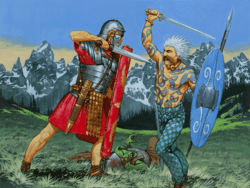Nethergate
- For the British brewery, see Nethergate Brewery. For the Nethergate area of Dundee, see City Centre, Dundee.
| Nethergate | |
|---|---|
 Nethergate Opening Screen | |
| Developer(s) | Spiderweb Software |
| Publisher(s) | Spiderweb Software |
| Designer(s) | Jeff Vogel |
| Platform(s) | Mac OS, Microsoft Windows |
| Release date(s) |
Original
|
| Genre(s) | Role-playing |
| Mode(s) | Single-player |
Nethergate is a computer-based historical-fiction fantasy role-playing game by Spiderweb Software available for the Macintosh and Microsoft Windows platforms. The game was released in 1998 by Jeff Vogel, and was Spiderweb Software's first game to feature a 45° isometric viewing angle. Nethergate offers the feature of being able to play on either side of the story, as Celts or Romans. The game has a plot which allows for several endings and many side quests, which flow alongside the main story. Spiderweb Software released a remake called Nethergate Resurrection in May 2007.
Plot
The Player begins with a party of four characters, who are either "A small band of Roman Soldiers sent to the Shadowvale to complete a mysterious mission," or a "Band of Celtic warriors told by your chief to go to the village of Nethergate for mysterious reasons". Shadowvale is an isolated valley controlled by the Brigantes and the games events take place during the time of Boudica's rebellion in 60/61 A.D. The linear missions of the Romans and the Celts complement each other to a certain extent. Romans are first faced with retrieving a satchel with vital information for Shadow Valley Fort from a nearby mine infested with Goblins, while the Celts' first mission is to acquire a bronze token from a nearby pit in which Goblins have made their fortification. From there, both sides make their way to the house of the Three Crones, who are very similar to the Three Fates of Greek Mythology. The Crones aid the player if they have a Roman party and give tasks to accomplish, but imprison them if the player has a Celtic party. The next location of travel is a ruined faerie hall, in which the party acquires a contract between the Sidhe and the village of Nethergate, explaining that the party must retrieve three magical items: a Fomorian’s Stone Skull, The Eye of Cathrac, and the Crown of Annwn. Once these items have been acquired, the party journeys to the Spire of Ages, where the Celts aid the Faerie leader in escaping this world, while the Romans attempt to interrupt him. In the "best" ending for both sides, Shadow Valley Fort is destroyed, the village of Nethergate is evacuated, and the enchanted weapons meant for the Celts have been destroyed.
Gameplay
Nethergate’s gameplay is in an isometric view, and is somewhat a stepping stone between that of Blades of Exile and Avernum, as it uses the pseudo-3D of Avernum, with a battle and conversation system which more resembles Blades of Exile. Romans and Celts have unique traits for their statistics. Romans have better armour and weapons than Celts, but Celts have better magic, potion making and general skills for the wilderness.
Nethergate is unique among Spiderweb Software games in being the only game to use a spell system consisting of Spell Circles, instead of the "Mage" and "Priest" spell system featured in the Exile and Avernum series. Certain Circles have skill restrictions on them based on the character's level of Druidism, skill in other circles, and Faction. These are:
- Health Circle – available to Celts and Romans, can only be as high as Druidism skill, contains spells used for healing and curing characters
- War Circle – available to Celts and Romans, can only be as high as Druidism skill, contains spells used for shielding and boosting your characters, as well as causing harm to enemies
- Beast Circle – available to Celts at start of game, Romans must earn it by completing a quest, may only be as high as War Circle skill for Celts, fixed value for Romans, contains spells for summoning creatures
- Craft Circle – available to Celts at start of game, Romans must earn it by completing a quest, may only be as high as the War Circle skill for Celts, fixed value for Romans, contains spells for aiding in travel around the game
- Spirit Circle – available to Celts at beginning of game, Romans must find it, may only be as high as the lower of Craft or Beast circle as Celts, fixed value for Romans, contains spells for damaging magical creatures and blocks
- Nether Circle – grouping of five spells, which may only be used by the Celts, also the most powerful and hard-to-find spells
Reception
Nethergate was reviewed in 2000 in Dragon #273 in the "Silicon Sorcery" column.
Nethergate: Resurrection
Nethergate: Resurrection, a revamped version of Nethergate, was released for Macintosh on May 21, 2007, with the Windows released later that year on August 9. Changes to the game include:
- Use of the Blades of Avernum game engine, which also provides a quest log, a nicer automap, and improved graphical features.
- Two new dungeons, several new quests, and many new magic items.
- The game is universal on Intel Macintosh and compatible with Windows Vista.
In addition to the new features, saved games from Nethergate are not compatible with Nethergate: Resurrection. Customers who had purchased the original game (Nethergate) also received a thirteen dollar discount.